Canonflex
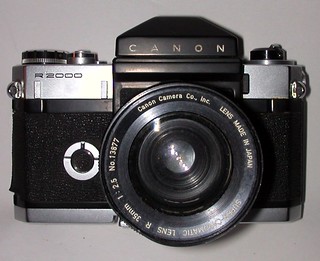
|
| The second Canonflex (R2000) image by rst12 (Image rights) |
The Canonflex 35mm SLR camera was launched in May 1959 by the Canon Camera Co., Tokyo, Japan. It is the first SLR camera from this, at the time, well known rangefinder camera manufacturer. They had already also established themselves as highly regarded lens manufacturer.
The Canonflex was one of a trio of SLRs introduced in early 1959 (along with the Nikon F and Zenza Bronica) which combined instant-return mirrors with auto-reopen lens diaphragms. Previous SLRs could not match the uninterrupted viewing of rangefinder cameras; but these innovations launched the SLR's emergence as the dominant camera design of the subsequent 50 years.
The Canonflex is very well built and well designed, with some quite original features, inspired by their rangefinders. First mention must be the base mounted, flap tipped, advance lever for the left-hand thumb. Next the easily removable finder-prism, which slides securely home when mounted. A small black button releases it for removal, situated just next to it, at the left-hand front. Further notable feature is the single shutter speed dial with equally spaced and clearly marked speed settings running from 1 through 1000, and X as well as B-T settings. The T setting is obtained by shifting a small lever under the shutter release collar to the left before depressing the button. Shutter is then closed by returning it to the original position. This feature is unmarked and might look like a shutter release lock, which it isn't. The shutter dial is prepared for taking the accessory clip-on exposure meter, hence the equally spaced stops and the cleverly scalloped edge hiding a coupling.
The lens mount is a breech-lock bayonet, possibly first seen on the 1952 Praktina, implementing a mount eliminating the wear of calibrated surfaces. The Canon R-mount is preferable to the Praktina one leaving the locking ring on the lens, with less risk of dropping the lens. The lens itself is equipped with the dual aperture ring found on all manual preset lenses at the time. This however, is a fully automatic lens: The front ring with click-stops sets the desired taking aperture, while the rear one provides a depth-of-field preview. Unfortunately, it actually overrides the preset value, if set to a smaller opening.
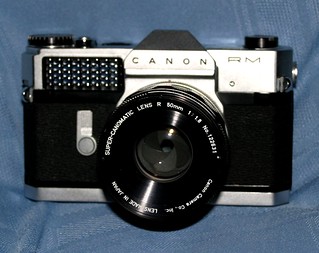
|
| Canonflex RM without removable prism image by rst12 (Image rights) |
The Canonflex has a cloth shutter-curtain unlike the contemporary rangefinder Canons, metal was considered unnecessary being protected by the mirror from sun burning it. The back is opened by a key at the base, turning it fully snaps open the door. The attention to details is apparent in these and other features, like the self-timer with a fold-out key and the nine-piece rewind lever. Under it is a eminently well designed film reminder, consisting of two scales for film speed and type.
Had the Canon Camera Company put as much effort and prestige into the marketing of their professional 35mm SLR cameras as did Nippon Kogaku, they might very well have overshadowed the Nikon F, but for the lack of a aperture ring connection and possibly the unusual placed wind lever. As it were, despite the camera itself certainly better built, they gave Nippon Kogaku a twelve years lead, a painful period in their history, and another eighteen years before beginning to close the gap.
The Canonflex may have been better built, although this seems entirely subjective, But the Nikon F was definitely a generally proven, simpler and more robust design, based as it was on the SP and S3 rangefinder cameras. The Canonflex was an entirely new and very complicated design with a weakness in the advance gear train in early cameras.
The standard lens for the Canonflex is Super-Canomatic R50 f:1.8 using the Canon R breech lock mount.
Canonflex R2000
The Canonflex stayed in production for just one year, and was replaced by the Canonflex R2000, with a shutter extending to 1/2000 sec. The total production of the Canonflex R2000 was about 8,800 units, with documented serial number range: 50646- 59281[1]
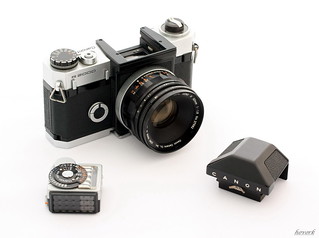
|
| Canonflex R-2000, with detachable prism and clip-on meter image by Hovsep Kevorkian (Image rights) |

|
| Canonflex R-2000 with articulated selenium meter image by Dirk HR Spennemann (Image rights) |
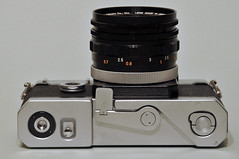
|
| Canonflex R-2000 base-mounted film advance image by Dirk HR Spennemann (Image rights) |
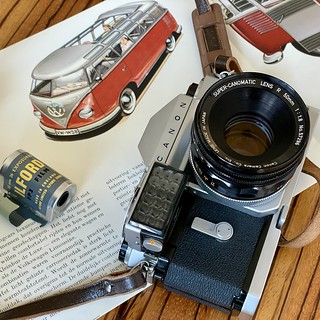
|
| Canonflex RP image by BobHteU (Image rights) |
Links
- Canon's 1st SLR the 1959 Canonflex at Cameraquest
- Canonflex at Marc's Classic Cameras -->
- Canon Canonflex RM at Sylvain Halgand's www.collection-appareils.fr (in French)
- Canonflex RP PDF manuals (English - Japanese) at OrphanCameras.com
Notes
- ↑ via IDCC-Internet Directory of Camera Collectors.